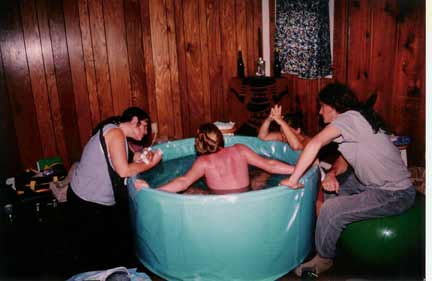
Both of my children were born in water. Obviously, I have a bias. In my experience, there were benefits of a water birth for both mother and baby. This positive experience was backed up by a medical study in 2010 finding a “Clear Medical Advantages of Water Birthing”.
Results suggest clear medical advantages of water birthing: significantly shorter labor duration among the primiparae; a net reduction in episiotomy rates; and a marked drop in requests for pain relievers.
Just like with almost anything else, you can find research supporting the opposite conclusion, as a new report states. Counsel & Heal explains:
However, a new report conducted by the American Academy of Pediatrics (AAP) Committee on Fetus and Newborn and the American College of Obstetricians and Gynecologists (ACOG) concluded that water births are dangerous for both the mother and newborn.
For this study, the team analyzed available data on water births. They separated the effects of water birth during early stage labor and late stage labor. Based on the data, the researchers stated that during early stage labor, sitting in a tub of water could help pregnant women relax. This phase was also tied to fewer epidurals and other anesthesia use, as well as a shorter labor. When the early stage transitioned to the late stage of labor, the researchers reported that giving birth while immersed in water did not reduce the number of perineal trauma or tears. It also did not reduce the women’s likelihood of requiring assisted vaginal deliveries or Cesarean sections.
The report also found that water births were tied to an increased risk of infections. When a newborn is born underwater, the baby’s ability to regulate his/her body temperature becomes jeopardized. Furthermore if the umbilical cord breaks apart unexpectedly, it could lead to hemorrhaging and shock. In the rare case, the newborn could end up drowning.
This new research does not contradict the earlier one about helping women during the early stages of labor, but I do take issue with the risks associated with babies. Like any medical practice, the experience of care providers is important. No experienced midwife would allow a baby to stay in the tub long enough to drown. That’s just ridiculous!
When babies are born, they are still receiving oxygen through the umbilical cord. During the first 15 minutes or so, the baby transitions to breathing through the lungs as the umbilical cord stops pulsing. This is one reason delayed cord clamping is beneficial.
This is also why it is highly unlikely a baby will drown water during a water birth.
Newborns are not allowed to float around in the water. In my experience, the newborn is lifted immediately to mama’s chest.
Furthermore, the 2010 study found the risk of infection was slight from a water birth.
Despite microbial contamination of birth pool water during delivery, antibiotic prophylaxis, as indicated by clinical and laboratory suspicion of infection, was administered to only 0.98% of babies after water birth versus 1.64% of those after land delivery…
During expulsion of the fetus at delivery, fecal matter is released into the birth pool water, contaminating it with micro-organisms. Despite this, water birthing was found to be safe for the neonate and did not carry a higher risk of neonatal infection when compared with conventional vaginal delivery.
Additionally the other concern of a baby regulating its body temperature is exactly one of the benefits not risks of a water birth.
Being born into water that is the same temperature as the mother’s body is an easier transition than to outside air that will most certainly be cooler.
Despite this report getting major media attention with headlines stating water births are not safe, the authors are a bit more cautious about the data. NPR reports:
“There’s actually pretty good evidence that it’s safe to labor in the tub,” says Dr. Aaron Caughey, an associate professor of maternal-fetal medicine at the University of California, San Francisco, and a member of the committee that wrote the opinion, which was published Thursday.
“But there’s less good evidence that it’s safe for the baby and even safe for the mom in terms of infection risk, to give birth in the tub.”
And of course that’s the first thing people want to know; is it safe? The biggest fear is that a baby could draw its first breath in the water, then choke or drown. The doctors note individual case reports of drowning or near drowning, both at hospitals and home births, but those reports don’t give any sense of what the circumstances were or how common those incidents might be.
“Case reports are the lowest form of evidence,” Shaw-Battista counters. She is completing a study of 1,200 women who labored or birthed in water, and says they did as well or better than women who did not. “Given the bulk of the data, I don’t think we should use case reports to reject options that women are currently enjoying.”
The actual report from The American College of Obstetricians and Gynecologist, a group that has not expressed favor for many natural birthing methods and midwives in general, we find they use the words “rare but serious adverse effects in newborn” to describe water birth in the second stage of labor. Complications are rare. Complications may happen with any birth. Certainly there are risks to medicated, hospital births. Statistically, I wonder how they compare.
Clearly, I am not a medical doctor, but a mother who experienced two water births who can’t imagine birthing any other way. If you are considering a water birth, it is definitely something to discuss with your doctor or midwife.
Leave a Reply